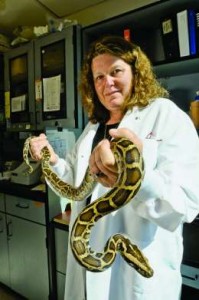Are YOU a snake-lover or an ophidiophobia (snake-phobia)?
Are snakes one of your favourite animals or are they your least? Although some may adore them, I am among the people who are terribly afraid of them, or what people call an ophidiophobia. Who would have known that, “pythons’ big heart [could] hold clues for human health[?]” (The Associated Press). Scientists now learned that when the pythons undergo digestion, their hearts expand to the size similar to that of an Olympic athlete. How is this relevant to human? Scientists now look for clues from the pythons’ powerful heart muscles that could potentially benefit human’s hearts. A molecular biologist at the University of Colorado in Boulder, Leslie Leinwand, found that the pythons’ hearts expand because they are building up more muscles.
There have also been studies done on the pythons’ digestion pattern. For instance, reptile biologists observed that Burmese pythons could survive for almost a year without food. Furthermore, once they resume the meals, their metabolism would increase up to more than 40-fold. After digestion, their organs, except the brain, would grow larger in size. Leinward notices this distinct observation and tries to make a connection to human heart diseases. For people with chronic high blood pressure, their hearts are not able to circulate the blood as well as normal hearts. However, vigorous exercise might be able to enhance the recovery and strengthen heart muscles just like those of the pythons.
How is the research being conducted? Dr. Leinwand and her team worked with baby pythons to study their internal organs in details. Dr. Leinwand came to a conclusion that for these pythons, the fatty acids increase up to as much as 50 times during digestion. Theirs cells grow bigger, thus resulting in a larger heart size. Python’s blood is also full of fat, mainly three specific fatty acids in a particular combination, that enables this capability. Do these fatty acids have negative impacts on their hearts’ conditions? No, instead, they act as the heart protection. The pythons can rapidly burn the fat, turning it into fuel for energy. In contrast, humans’ metabolisms are not that efficient so the cells would accumulate fat and the accumulation might contribute to various heart diseases. As for the pythons, they already have enzymes to protect their hearts from damages during digestion.
A video on Dr. Leinwand’s interview in her laboratory.
One of the main researchers, Cecilia Riquelme, studied the applications of this knowledge. First, she bathed a rat’s heart cells with the plasma, blood cell, from the snake. The result turned out that the content of the python’s blood made the heart cells grew bigger and stronger. Researchers now continue to study that if putting fatty acid from the pythons’ blood into the rats would lead to any beneficial growths.
This is relevant to us because if these rats could benefit from the fatty acids and have their heart muscles strengthen, it implies that the pythons could be the key in helping human with heart diseases. Pythons may after all become our heroes!
Further Resources:
http://www.newscientist.com/article/dn21099-a-shot-of-snake-blood-makes-the-heart-grow.html
References:
http://www.cbc.ca/news/technology/story/2011/10/28/python-heart.html


November 13th, 2011 at 11:30 am
Cool! Who would have thought that fatty acids may actually cure heart disease? I always thought of fatty acids as the bad guys in heart disease so this is something very new to me.
ps. what happened to the picture of the snake swallowing a huge meal? Was it too disturbing?
November 13th, 2011 at 1:06 pm
Did you see that one? It was actually a snake eating a sheep. I took it out because I wasn’t sure if it was relevant. Though initially I was trying to show the meal size and how their bodies or organs expand, but in the end I found it too disturbing. And yes I always thought fatty acids are bad. If these snakes don’t have fast metabolism then the accumulation of fatty acids would have damaged their healths as well.